Chemical Hazard Information
The Globally Harmonized System (GHS) of hazard warning labels and information is now used on chemical containers and safety data sheets (SDSs). The GHS includes symbols, as well as signal words ("Danger" or "Warning"), hazard statements and associated codes, and precautionary statements. An overview of the GHS system can be found here:
A Guide to The Globally Harmonized System of Classification and Labelling of Chemicals (GHS)
Detailed information on the GHS can be found in the following United Nations Economic Commission for Europe (UNECE) web document:
Globally Harmonized System of Classification and Labelling of Chemicals (GHS)
COMPRESSED GAS |
CORROSIVE |
ENVIRONMENTALLY DAMAGING |
EXPLOSIVE |
FLAMMABLE |
HEALTH HAZARD |
IRRITANT |
OXIDIZER |
TOXIC |

Gases Under Pressure
Definition: A gas which when packaged under pressure is entirely gaseous at -50 °C; including all gases with a critical temperature ≤ -50 °C.
Symbol Usage: compressed gases, liquified gases, refrigerated liquified gases, dissolved gases
Examples: ammonia, argon, liquid nitrogen
Corrosives
Definition: A substance or a mixture that is corrosive to metal is a substance or a mixture which by chemical action will materially damage, or even destroy, metals.
Skin Corrosion is the production of irreversible damage to the skin; namely, visible necrosis through the epidermis and into the dermis, following the application of a test substance for up to 4 hours.
Corrosive reactions are typified by ulcers, bleeding, bloody scabs, and, by the end of observation at 14 days, by discolouration due to blanching of the skin, complete areas of alopecia, and scars. Histopathology should be considered to evaluate questionable lesions.A single harmonized corrosion category is provided in Table 3.2.1, using the results of animal testing. A corrosive is a test material that produces destruction of skin tissue, namely, visible necrosis through the epidermis and into the dermis, in at least 1 of 3 tested animals after exposure up to a 4 hour duration. Corrosive reactions are typified by ulcers, bleeding, bloody scabs and, by the end of observation at 14 days, by discoloration due to blanching of the skin, complete areas of alopecia and scars. Histopathology should be considered to discern questionable lesions.
Symbol Usage:
Examples:
Environmental Toxicity
Definition: Acute aquatic toxicity means the intrinsic property of a substance to be injurious to an organism in a short-term exposure to that substance.
Chronic aquatic toxicity means potential or actual properties of a substance to cause adverse effects to aquatic organisms during exposures which are determined in relation to the life-cycle of the organism.
Symbol Usage: acute or chronic hazards to the aquatic environment
Examples: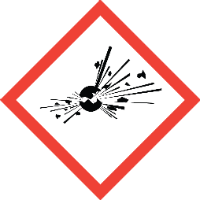
Explosives
Self Reactives
Organic Peroxides
Definition: A solid or liquid substance (or mixture of substances) which is in itself capable by chemical reaction of producing gas at such a temperature and pressure and at such a speed as to cause damage to the surroundings. Pyrotechnic substances are included even when they do not evolve gases.
Self-reactive substances or mixtures are thermally unstable liquid or solid substances or mixtures liable to undergo a strongly exothermic decomposition even without participation of oxygen (air).
This definition excludes substances and mixtures classified under the GHS as explosives, organic peroxides or as oxidizing.Symbol Usage: explosives, self-reactive substances and mixtures, organic peroxides
Examples: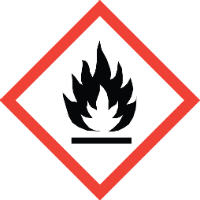
Flammables
Self Reactives
Pyrophorics
Self-Heating
Emits Flammable Gas
Organic Peroxides
Definition: A gas having a flammable range with air at 20 °C and a standard pressure of 101.3 kPa; a liquid having a flash point of not more than 93 °C; or a solid which is readily combustible, or may cause or contribute to fire through friction.
A pyrophoric liquid or solid is a material which, even in small quantities, is liable to ignite within five minutes after coming into contact with air.
Substances or mixtures which, in contact with water, emit flammable gases are solid or liquid substances or mixtures which, by interaction with water, are liable to become spontaneously flammable or to give off flammable gases in dangerous quantities.Symbol Usage: flammable gases, liquids, and solids; pyrophoric materials; non-explosive self-reactive materials; water-reactives; non-explosive organic peroxides
Examples:
Carcinogen
Respiratory Sensitizer
Reproductive Toxicity
Target Organ Toxicity
Mutagenicity
Aspiration Toxicity
Definition: A respiratory sensitizer is a substance that will induce hypersensitivity of the airways following inhalation of the substance. A skin sensitizer is a substance that will induce an allergic response following skin contact.
This hazard class is primarily concerned with chemicals that may cause mutations in the germ cells of humans that can be transmitted to the progeny.
Reproductive toxicity includes adverse effects on sexual function and fertility in adult males and females, as well as developmental toxicity in the offspring.
The term carcinogen denotes a chemical substance or a mixture of chemical substances which induce cancer or increase its incidence. Substances which have induced benign and malignant tumours in well performed experimental studies on animals are considered also to be presumed or suspected human
carcinogens unless there is strong evidence that the mechanism of tumour formation is not relevant for humans.
Classification of a chemical as posing a carcinogenic hazard is based on the inherent properties of the substance and does not provide information on the level of the human cancer risk which the use of the chemical may represent.CATEGORY 1: Known or presumed human carcinogens
The placing of a chemical in Category 1 is done on the basis of epidemiological and/or animal data. An individual chemical may be further distinguished:
Category 1A: Known to have carcinogenic potential for humans; the placing of a chemical is largely based on human evidence.
Category 1B: Presumed to have carcinogenic potential for humans; the placing of a chemical is largely based on animal evidence.CATEGORY 2: Suspected human carcinogens
The placing of a chemical in Category 2 is done on the basis of evidence obtained from human and/or animal studies, but which is not sufficiently convincing to place the chemical in Category 1. Based on strength of evidence together with additional considerations, such evidence may be from either limited evidence of carcinogenicity in human studies or from limited evidence of carcinogenicity in animal studies.The purpose of this chapter is to provide a means of classifying substances that produce specific, non lethal target organ/systemic toxicity arising from a single exposure. All significant health effects that can impair function, both reversible and irreversible, immediate and/or delayed are included.
The purpose of this document is to provide a means of classifying substances that produce specific target organ/systemic toxicity arising from a repeated exposure. All significant health effects that can impair function, both reversible and irreversible, immediate and/or delayed are included.
Symbol Usage: sensitizers, carcinogens, mutagens, reproductive toxicants, specific target organ toxicants
Examples: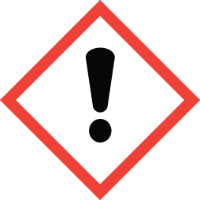
Irritant
Dermal Sensitizer
Acute toxicity (harmful)
Narcotic Effects
Respiratory Tract
Irritation
Definition: Skin Irritation is the production of reversible damage to the skin following the application of a test substance for up to 4 hours.
Symbol Usage: skin irritatant, eye irritant, respiratory irritant, narcotics
Examples: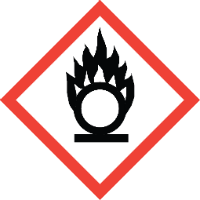
Oxidizers
Definition: any gas which may, generally by providing oxygen, cause or contribute to the combustion of other material more than air does; a liquid which, while in itself not necessarily combustible, may, generally by yielding oxygen, cause, or contribute to, the combustion of other material; or a solid which, while in itself not necessarily combustible, may, generally by yielding oxygen, cause, or contribute to, the combustion of other material.
Self-reactive substances or mixtures are thermally unstable liquid or solid substances or mixtures liable to undergo a strongly exothermic decomposition even without participation of oxygen (air).
This definition excludes substances and mixtures classified under the GHS as explosives, organic peroxides or as oxidizing.Symbol Usage: oxidizing gases, liquids, and solids
Examples:
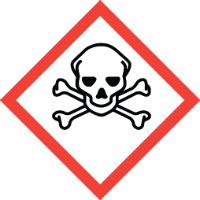
Acute toxicity (severe)
Definition: Acute toxicity refers to those adverse effects occurring following oral or dermal administration of a single dose of a substance, or multiple doses given within 24 hours, or an inhalation exposure of 4 hours.
Symbol Usage:
Examples:
